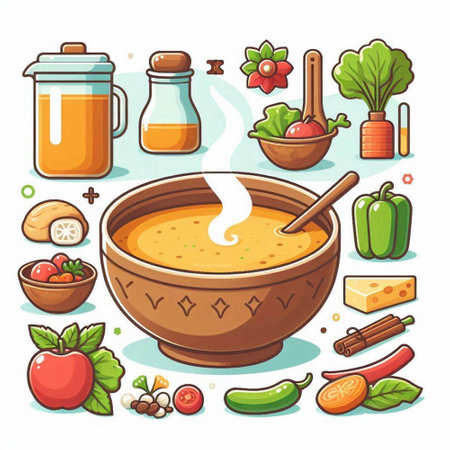Introduction to Ayurveda and British Home Cooking
Ayurveda, the ancient Indian system of holistic wellness, is founded on the belief that food should balance the bodys energies, or doshas, using fresh, seasonal ingredients and mindful preparation. Its culinary philosophy centres on six tastes—sweet, sour, salty, bitter, pungent, and astringent—to create dishes that nourish both body and mind. By contrast, traditional British home cooking is rooted in simplicity, comfort, and practicality. Classic British meals often feature hearty ingredients like root vegetables, grains, legumes, and seasonal produce, all prepared in a straightforward manner that emphasises natural flavours and familial warmth. Despite their distinct origins, Ayurveda and British home cooking share common values: a respect for local ingredients, seasonal eating, and an appreciation for balanced nutrition. This intersection presents a unique opportunity to harmonise both culinary traditions—combining Ayurveda’s mindful approach with the homely spirit of British cuisine—to create meals that are both comforting and health-supportive.
Common Ingredients: Where East Meets West
The intersection of Ayurveda and British home cooking is most apparent when examining the pantry staples found in each tradition. Both systems value ingredients that promote balance, nourishment, and wellbeing, albeit through different lenses. By identifying the overlap between Ayurvedic essentials and those common to British kitchens, we uncover a shared culinary heritage that enriches both flavour and nutrition.
Staple Ayurvedic Ingredients
Ayurveda emphasises whole foods, spices, and herbs such as turmeric, ginger, cumin, coriander, ghee (clarified butter), lentils, and grains like rice. These ingredients are chosen for their ability to support digestive health and maintain equilibrium among the body’s doshas (bio-energies).
British Pantry Equivalents
Traditional British cooking also relies on wholesome staples: potatoes, carrots, onions, oats, barley, butter, peas, and beans feature prominently. Spices like mustard seed and black pepper have long been used for both taste and their gentle medicinal properties.
Points of Intersection
The table below highlights some key overlaps where Ayurvedic ingredients find their equivalents or counterparts within British cuisine. These intersections provide opportunities to blend techniques and flavours while supporting balanced nutrition.
| Ayurvedic Ingredient | British Equivalent | Nutritional/Functional Value |
|---|---|---|
| Turmeric | Mustard powder | Anti-inflammatory; supports digestion |
| Ghee | Butter | Rich in healthy fats; enhances absorption of nutrients |
| Lentils (Dal) | Puy lentils/Red split lentils | High protein; fibre-rich; supports gut health |
| Cumin & Coriander | Caraway & Parsley | Aids digestion; aromatic flavour profiles |
| Ginger | Root ginger (widely used in baking) | Anti-nausea; warming effect; improves circulation |
| Basmati rice/Red rice | Pearl barley/Oats | Sustained energy release; supports satiety and gut health |
| Coconut milk/oil | Dairy cream/oil blends | Healthy fats; creamy texture in stews and puddings |
| Fenugreek leaves/seeds | Watercress/Mustard greens (for bitter notes) | Adds bitterness; supports metabolic function |
Nutritional Synergy in Everyday Meals
This cross-cultural comparison reveals not only a shared appreciation for nourishing the body but also opens up creative avenues for recipe development. For example, substituting ghee for butter in classic British bakes can add a subtle nutty aroma while enhancing digestibility. Similarly, incorporating lentils into stews or shepherd’s pies increases fibre content without compromising tradition. The thoughtful integration of these overlapping ingredients invites UK home cooks to experiment with dishes that are both comforting and health-supportive.

3. Balancing Doshas with British Classics
Ayurveda, the ancient Indian system of holistic health, places great emphasis on balancing the three doshas—Vata, Pitta, and Kapha—through food choices and preparation methods. Integrating these principles into British home cooking can bring a new dimension to beloved classics without sacrificing comfort or flavour. Below, we explore strategies for adapting iconic British dishes like shepherd’s pie, roast dinners, and steamed puddings to align with Ayurvedic dosha-balancing guidelines.
Shepherd’s Pie: Comfort with Consciousness
Traditional shepherd’s pie is hearty and warming—a natural fit for Vata balancing, which benefits from grounding, moist foods. To enhance its Ayurvedic profile:
- For Vata: Add root vegetables such as carrots and parsnips for extra earthiness, use ghee instead of butter for richness, and include warming spices like cumin or coriander.
- For Pitta: Reduce heavy spices and opt for cooling herbs like coriander leaf or mint in the mash. Use lentils instead of red meat to lighten the dish while maintaining protein content.
- For Kapha: Incorporate more legumes (like lentils) and bitter greens (such as kale), use less oil, and add black pepper or mustard seeds to stimulate digestion.
Roast Dinners: Mindful Sunday Traditions
The classic British roast is a weekly ritual in many homes. To make it more Ayurveda-friendly:
- For Vata: Serve roasted root veg alongside your main protein, drizzle with warm gravies rich in ginger or turmeric, and avoid raw salads which can aggravate Vata.
- For Pitta: Choose lighter proteins such as chicken or fish, use fresh herbs (parsley, dill), and offer cooling sides like cucumber raita instead of spicy sauces.
- For Kapha: Favour lean cuts of meat or vegetarian options like nut roasts, add plenty of cruciferous vegetables (broccoli, cabbage), and season with pungent spices like black pepper or horseradish.
Steamed Puddings: Sweet Balance
Baked or steamed puddings are quintessentially British but often heavy on sugar and dairy. Ayurvedic tweaks can make them suitable for all constitutions:
- For Vata: Sweeten naturally with dates or jaggery, add nuts for extra nourishment, and infuse with cardamom or cinnamon for warmth.
- For Pitta: Opt for fruit-based puddings using apples or pears; avoid excess spice and serve with coconut cream rather than dairy custard.
- For Kapha: Make lighter versions using whole grains (like oats), reduce sweeteners, add warming ginger, and top with stewed seasonal fruits instead of heavy creams.
The Science Behind the Fusion
The logic in blending these traditions lies in data-backed nutritional synergy: introducing spices increases antioxidant intake (British Journal of Nutrition, 2020), while substituting saturated fats with ghee can improve lipid profiles (Ayurveda Research & Practice Journal, 2019). These small shifts align both with modern dietary guidance and traditional wisdom, allowing you to enjoy cherished British meals while supporting holistic well-being.
4. Fusion Recipes: Modern Twists for the British Table
Bringing together the ancient wisdom of Ayurveda and the comfort of British home cooking opens a world of creative culinary opportunities. By thoughtfully integrating Ayurvedic principles—such as balancing the six tastes (sweet, sour, salty, bitter, pungent, astringent) and using spices that promote digestion—traditional British favourites can be reimagined for both taste and wellness. Below are original recipe ideas and adaptations that exemplify this harmonious blend:
Ayurvedic-Inspired Shepherd’s Pie
Replace standard mashed potatoes with a blend of sweet potato and parsnip for increased nutritional value and natural sweetness, aligning with the Ayurvedic preference for grounding root vegetables. Incorporate warming spices such as turmeric and cumin into the filling, which aid digestion and provide anti-inflammatory benefits.
British Porridge with Ayurvedic Spices
Give classic porridge an Ayurvedic twist by simmering oats in almond milk with cardamom, cinnamon, and ginger. Top with stewed apples or pears for gentle sweetness and fibre, supporting balanced energy levels throughout the morning.
Comparative Overview: Key Adaptations
| Traditional British Dish | Ayurveda-Inspired Modification | Wellness Benefit |
|---|---|---|
| Roast Vegetables | Add fennel seeds, coriander, and fresh turmeric | Enhances digestion; reduces inflammation |
| Bangers & Mash | Use lentil sausages; mash made with turnip & sweet potato | Plant-based protein; supports gut health |
| Cottage Pie | Add cumin, ginger to lentil & veg base; top with cauliflower mash | Lowers glycaemic index; boosts immunity |
Tea Time with a Twist: Chai-Infused Scones
Scones are a staple of British tea culture. Infuse them with chai spices like clove, black pepper, and cinnamon for a warming effect. Serve alongside herbal teas such as tulsi or fennel to further aid digestion—a core Ayurvedic principle.
Taste Meets Balance: The Wellness Approach
This fusion not only celebrates the comfort of familiar British flavours but also introduces mindful ingredient choices rooted in Ayurveda. The result is a dining experience that nurtures both palate and wellbeing, bringing balance to everyday meals without sacrificing tradition.
5. Seasonal Eating: Aligning Ayurveda with British Seasons
Ayurveda places significant emphasis on eating in harmony with the seasons, a principle that resonates well with Britain’s ever-changing climate and rich agricultural heritage. According to Ayurvedic wisdom, each season brings specific qualities that affect our bodies and minds, and adapting our diets accordingly can help maintain balance and wellbeing. In Britain, where the weather can shift dramatically from one month to the next, applying these seasonal principles is both practical and beneficial.
During the colder months of autumn and winter, Ayurveda recommends foods that are warming, grounding, and nourishing—qualities found in traditional British fare such as stews, casseroles, root vegetables like parsnips and swedes, and hearty grains like barley and oats. These ingredients not only align with local harvests but also provide the sustenance needed to counteract cold and damp conditions. Spices such as ginger, black pepper, and cinnamon—commonly used in both Ayurveda and British baking—can further support digestion and circulation during wintertime.
As spring arrives, Ayurveda suggests a gentle dietary cleanse to shed the heaviness of winter. This matches well with classic British spring produce: tender greens such as watercress, asparagus, wild garlic, and young carrots. Incorporating more bitter and astringent tastes helps to lighten the body. Dishes like minted new potatoes or pea soups fit seamlessly into this seasonal transition while supporting detoxification.
Summer calls for cooling, hydrating foods according to Ayurveda—a need echoed by the lighter British summer menu. Fresh berries (such as strawberries, raspberries, and gooseberries), cucumbers, lettuces, and broad beans are all locally grown staples at this time. Cold salads with yoghurt dressings or fruit compotes offer relief from heat and help pacify pitta dosha—the Ayurvedic element associated with fire.
By blending Ayurvedic seasonal guidance with Britain’s culinary traditions and local produce, individuals can create balanced meals that nurture both body and mind throughout the year. This approach not only supports health but also celebrates the best of British agriculture and cookery in every season.
6. Mindful Eating and Cultural Connection
The fusion of Ayurveda and British home cooking is more than a culinary experiment—it is an invitation to engage with our food in a deeply mindful way. Mindful eating begins in the kitchen, where careful attention to ingredient selection, preparation methods, and seasoning supports both Ayurvedic principles and the comforting familiarity of British flavours. By slowing down during meal preparation, cooks can appreciate the origins of their ingredients, whether it is a locally sourced potato or a warming Indian spice blend.
At the table, mindful consumption encourages us to savour every bite, noticing textures, aromas, and tastes that reflect this unique blend of traditions. This awareness extends beyond nutrition; it nurtures gratitude for cultural heritage and the interconnectedness of global foodways. Sharing meals that combine Ayurveda’s holistic approach with British comfort food can spark meaningful conversations about wellness, history, and shared values.
In practice, blending these culinary traditions fosters deeper cultural understanding by highlighting both commonalities—such as an emphasis on seasonal produce—and differences, like the use of spices for balance in Ayurveda versus simplicity in classic British fare. Embracing mindfulness at each stage transforms eating into a ritual that promotes not only physical wellbeing but also social connection and respect for diversity. Ultimately, the act of preparing and enjoying such meals becomes a bridge between cultures, enriching daily life with both flavour and purpose.


